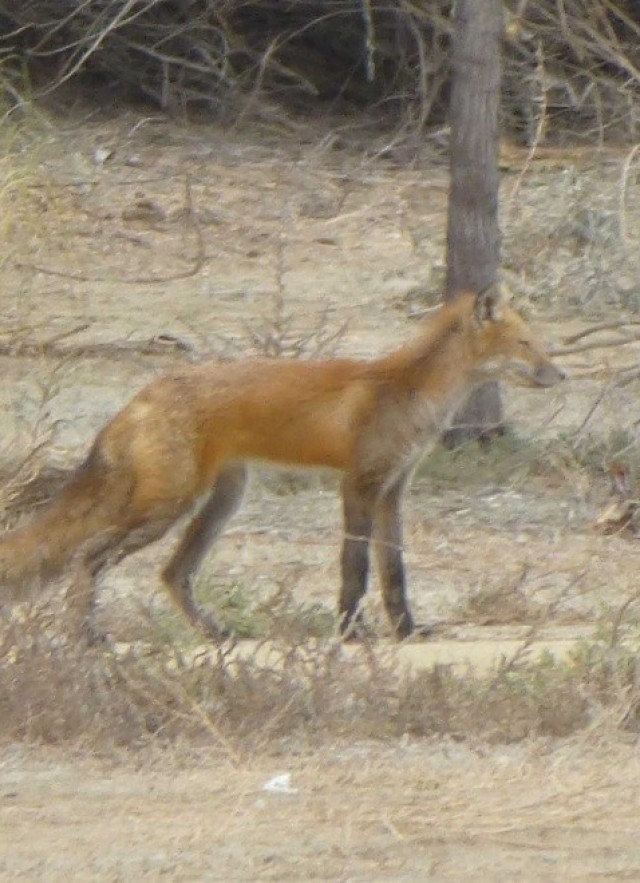Red Fox Sighted in San Pedro: From Fox Farms to Coyote Food
On a recent visit to San Pedro, the Natural History Museum of Los Angeles County’s Kimball Garrett crossed paths with a non-native red fox (Vulpes vulpes) near the 22nd Street Landing.

On a recent visit to San Pedro, the Natural History Museum of Los Angeles County's Kimball Garrett crossed paths with a non-native red fox (Vulpes vulpes) near the 22nd Street Landing . Although unusual now, red fox sightings were commonplace in many parts of coastal Southern California just a few decades ago.

If red foxes aren’t native, how did they get to Southern California in the first place? Not surprisingly, their introduction was anthropogenic, the result of human activities. From 1905 to 1919, red foxes from the eastern United States were imported into Orange County specifically for the sport of fox hunting. Simultaneously, the farming of imported foxes for the fur industry was becoming widespread throughout California. More than 100 fox farms existed across the state by the 1940s.
Escapees and deliberate releases from both enterprises quickly became comfortable in their new environs, reproducing and expanding their population and distribution. Museum specimen records show that by the 1970s red foxes had become established widely throughout the region, with salvaged roadkill specimens collected from North Hollywood, Glendale, the Palos Verdes Peninsula, and nearby beach cities. Red foxes, like many introduced species that become successfully established, are generalists that easily adapt to new environments. They are capable of surviving—even thriving—in diverse habitats and on widely variable diets.
More often than not, however, the success of an introduced species is to the detriment of native wildlife. The population of red foxes boomed in Southern California in the 1980s and '90s, inflicting ecological devastation along the way. Red foxes actively preyed upon native species, many of which were already in trouble due to habitat loss. This included ground-nesting shorebirds and songbirds, lizards, snakes, rabbits, and native mice. At Orange County’s Seal Beach Naval Weapons Reserve and Bolsa Chica Wetlands, as well as the Ballona Wetlands in Los Angeles County, populations of endangered bird species such as the light-footed clapper rail, the least tern, and Belding’s Savannah sparrow were brought to the verge of extinction. Red foxes were also likely responsible for causing the local extinction of the Pacific pocket mouse from habitats like the El Segundo Dunes. Efforts by the US Fish and Wildlife Service to eliminate the non-native red fox were met with harsh criticism by animal rights activists, despite the looming threat to the endangered native fauna. Lawsuits ensued and much time and money was lost defending the effort to eradicate the non-native predators. In the end, a lower profile program that targeted red foxes in specific areas resulted in a rebound of the native bird colonies in the late 1990s.
In addition to their hunting prowess, red foxes easily spread and thrived in Southern California due to their ability to adapt to just about any environment. While urban infrastructure is an impediment to species like the mountain lion, to the red fox it presents opportunity. Research published in 1999 by Jeff Lewis and Rick Golightly, of Humboldt State University, documented how red foxes in Southern California use flood control channels, freeway underpasses, railroad and highway corridors, and power line right-of-ways to move around and expand into new territories. They are also comfortable making their dens in culverts, at golf courses and parks, or even alongside busy freeways. In light of their extraordinary adaptability, why have red fox sightings remained uncommon? One possibility is that coyotes actively suppress and kill red foxes. As coyotes have expanded into urban areas, they are taking over the same niche formerly occupied by the red foxes. It very well might be that the native coyote is succeeding where frustrated wildlife managers couldn’t: eliminating the introduced red fox.